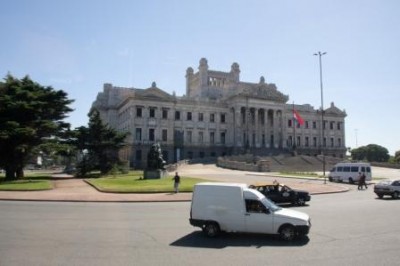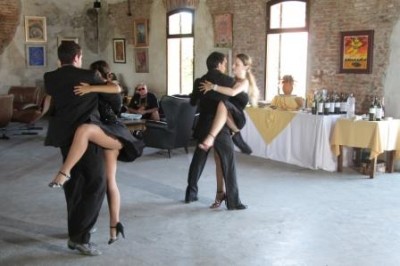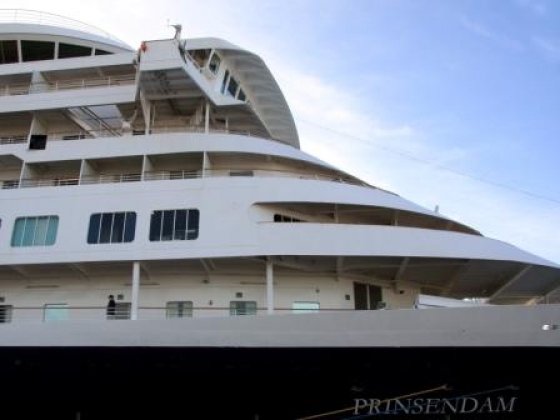The ocean to the southwest of Rio is dotted with islands and its mountainous coast is covered with almost virgin forest. By break of morning the idyllic landscape woke up, together with us. One last day “On Shore in Brazil” awaited us, in Paraty. Because the shallowness of the bay waters, the Prinsendam dropped its anchor five miles out the local “harbor”; if we would get in any closer, the bridge announced, we could all walk to shore! As Jesus was nowhere to be seen to give us a helping hand, we were looking at a thirty minute “transfer”, by tender.
Paraty, according to a guide that I had bought at home, was a classic, colonial, picturesque village in a golden bay. I decided that it was small enough to go and inspect the little town on my own. Correction, when a ship with 700 passengers docks, you cannot be alone in a village of one square mile!
Thank God (Him again), we did not have to suffer the stuffy, plastic tenders; the bosses had chartered two schooners. Rather than using the sails, they puffed along on their noisy but somehow charming diesel engines and, most importantly, they offered protection from the sun as well as a lot of welcome ventilation.

Paraty was already wilting under the sun-leaden sky, as we climbed ashore. Apart from a few schooners – the fishing boats and luxury yachts were moored further away – the pier was dominated by colorful, lazy love boats, invitingly eyeing, by virtue of their venetian-flair skippers, the passers-by. With names like Aphrodite, My Love, Passione, Paz e Amor (link?), etcetera one couldn’t resist to drift away, if not literally then figuratively! If there would have been a boat named “Carinha”, I would have gladly rented it for a couple of hours to sail away, eyes closed, along the bay – the town could have waited! But there wasn’t, so I marched on, courageously.
I circled in square circles) the little colonial pearl for more than an hour. As the guide predicted, it was a well preserved colonial setting, Portuguese style from end to end. It had three churches: one for the “whites” (aptly called “de los Remedios”, where they could pray for good health), one for the “blacks slaves” (financed by the whites, aptly called “del Rosario”, where they could pray rosaries for hours on end, after work of course) and one somewhat special. That was built by the black slaves, for themselves, and aptly named Santa Rita, a saint who was meant to deliver them from slave labor (and eventually did).
Not having found the “Carinha” love boat earlier, I found an alternative. Intrinsically it was nowhere near the real Carinha, but the name was close: CAipeRINHA. Tucked away in the western corner of the main “Praça”, or square (where they were building their own little Sambadrome), the bar, and the young folks tending it, were too enticing to just pass them by. The Caiperinha was excellent: some titillating and strong Cachaça (distilled from sugar cane, not unlike rum), with lime and ice. To make sure that I could still walk straight to the schooner, I also ordered a glass of Guaranà. That is the commercialized version of the drink that Indians brewed (with teaspoons of powder and Rio Negro water) before going hunting for two nights – in the old days! I am surprised that nobody has taken this drink to western markets yet, they could make a killing! I made it back to the Prinsendam in one piece, albeit soaking wet.
Paraty was the final port of call, a tender port as well, which is more in tune with the land and its people than a regular docking port. We left the bay as a thunderstorm moved in. Unfortunately, the rough seas associated with it would accompany us through the night. And the next day “at sea” didn’t pass any better. We had to put up with the roughest seas since leaving the Caribbean. Luckily it started to rain around noon, a downpour that lasted hours. It doused the waves somewhat but at dinner there were many empty chairs, with another day “at sea” to come!
Poseidon had reined in his wild horses (or his trashing nymphs?) by the time the sun rose today, around 6:30am. As a matter of fact, the weather would improve considerably as the day wore on, and after lunch it was a glorious day – at sea! Around 2pm we crossed the invisible border with Uruguay. After more than three weeks of cruising in rivers and around landmasses, I find it difficult to say “Goodbye Brazil”. I prefer “So long Brazil” instead. This country tempts, surprises and invites: the land, the people and, surely, the power that the combination creates are compelling; no less.
The country is, unavoidably, a conglomeration of very different regions. That is no surprise when considering its size and diversity: surface as well as population as well as culture. Along the mighty Amazon the economy is least developed, yet people live very closely tied to nature and don’t seem to crave western riches. Its geography – immeasurably grand, crisscrossed by massive rivers and densely wooded – precludes the easy introduction of primary utilities and services. “Light for everyone” is in full swing, and electricity is relatively easy to transport. But what about clean water? What about enhanced education and employment opportunities? What about improved medical care? Wherever one cares to look, the challenges are enormous. Yet, locals – be they Indian, black, white or mixed, look generally happy with their kind of life, their kind of world. They are not impatiently elbowing their way into more money or more luxury. The Amazon region is, in all its aspects – for observed and observers – a “moving” place.
The northeast, the bulge between the Amazon mouth and Salvador, encounters probably the toughest challenges to create sufficient levels of prosperity. Nobody will die from hunger, thanks to fishing and abundant fruits and vegetables, but, apart from the seducing beaches and a little bit of commerce with the dry hinterland (= the sertaõ, a semi-arid desert), this part has little excitement to offer its inhabitants. Luckily population density, as well as population growth, is falling. Malthus, contrary to what we observe in the Nile valley, has done some effective and beneficial “christening”.
Salvador, technically considered part of the (poorer) northeast, is a different animal all together. I consider it the only “Culture-rich Metropolis” (in western terms) from the cities that I visited. Apart from a cosmopolitan atmosphere and similar aspirations, Salvador has a past that is an integral part of its present. This is not just due to colonial villas and palaces, but also because of the integration of old folksy neighborhoods with the palpable presence of a living and live melting pot of races, cultures and social classes. Salvador, without a doubt, has an undeniable personal identity and buoys with all kinds of life.
And finally there is Rio de Janeiro. Nobody should be surprised when I put Rio in the class of “cosmopolitan world cities”. Although the city, with respect to architecture, is a far cry from almost all its star competitors on the face of the earth – as a matter of fact, I happen to think that Rio is sorely lacking in this particular area of “culture” – it can lay claims to all the other required characteristics for world class. And where it comes to natural beauty, it scores way better than the colleagues. Nature has shaped an exquisite and unequalled stage in and around Rio!
If nothing else, Rio stands out because of the dynamism it projects. People are busy, are helpful, are friendly, are entrepreneurial, are active (also on the beaches!), and are happy. Money is not unimportant, but does not appear to be the absolute priority. The motto “work to live rather than live to work” is not a distant dream but, ostensibly, daily practice. Building the Samba floats rather than earning extra moneys as a cab driver, is a case in point. Surely, the favela’s are also part of Rio, and present their own, different face; a face of poverty, drugs and violence. Yet, that is not unlike comparable cosmopolitan super cities.
BRIC – Brazil, Russia, India and China – is a focus point in financial circles. They have quickly become economical powerhouses. While a country of more than 3 million square kilometers with 200 million inhabitants can veer off in many directions, I think it is a safe bet that Brazil will do very well, if only because its people show confidence in their own and in their country’s potential, and they trust that their future is promising, all of which is bundled in an extremely extravert and positive attitude with regard to their region, their city, their village and their neighbors!
This concludes the story, not the story of just one day, but the story of a month of exploring and observing this buoyant country. Tomorrow we are in Montevideo, undoubtedly another world!
Prinsendam, Day 31 – Friday Feb 4th, 2011
“I see the mountain”, not just yet!
 Het echte centrum is een paar vierkante kilometer groot, en doet aan een provinciale grootstad denken, à la Bilbao, Oporto of, met een beetje goede wil, Bordeaux. Buiten dit kleine rijk- en druk-aandoende stadsdeel is het een beetje wenen met de pet op. De mooie gebouwen uit het begin van de 20ste eeuw zijn vervallen en niet onderhouden, en ertussen, schamel en verdoken, staan vierkante huisjes, laag en scheef, waar de stroop niet van de muren loopt. Buiten de stad zelf worden de huisjes nog kleiner, de straten stoffiger en de mensen krommer.
Het echte centrum is een paar vierkante kilometer groot, en doet aan een provinciale grootstad denken, à la Bilbao, Oporto of, met een beetje goede wil, Bordeaux. Buiten dit kleine rijk- en druk-aandoende stadsdeel is het een beetje wenen met de pet op. De mooie gebouwen uit het begin van de 20ste eeuw zijn vervallen en niet onderhouden, en ertussen, schamel en verdoken, staan vierkante huisjes, laag en scheef, waar de stroop niet van de muren loopt. Buiten de stad zelf worden de huisjes nog kleiner, de straten stoffiger en de mensen krommer. Inmiddels varen we op de Rio de la Plata. Er staat een harde wind en het estuarium heeft een wit kuifje. Aangezien het zeer ondiep is – elk kwartier klinkt het alsof de schroeven door de modder ploeteren – valt de hoogte van de golven mee. Vannacht krijgen we van de tijdgoden weer en uurtje terug; in Buenos Aires zijn we terug vier achter op Brussel. Ik vrees dat we dat uurtje volgende week, onderweg naar de Falklands, snel zullen moeten prijsgeven.
Inmiddels varen we op de Rio de la Plata. Er staat een harde wind en het estuarium heeft een wit kuifje. Aangezien het zeer ondiep is – elk kwartier klinkt het alsof de schroeven door de modder ploeteren – valt de hoogte van de golven mee. Vannacht krijgen we van de tijdgoden weer en uurtje terug; in Buenos Aires zijn we terug vier achter op Brussel. Ik vrees dat we dat uurtje volgende week, onderweg naar de Falklands, snel zullen moeten prijsgeven.

